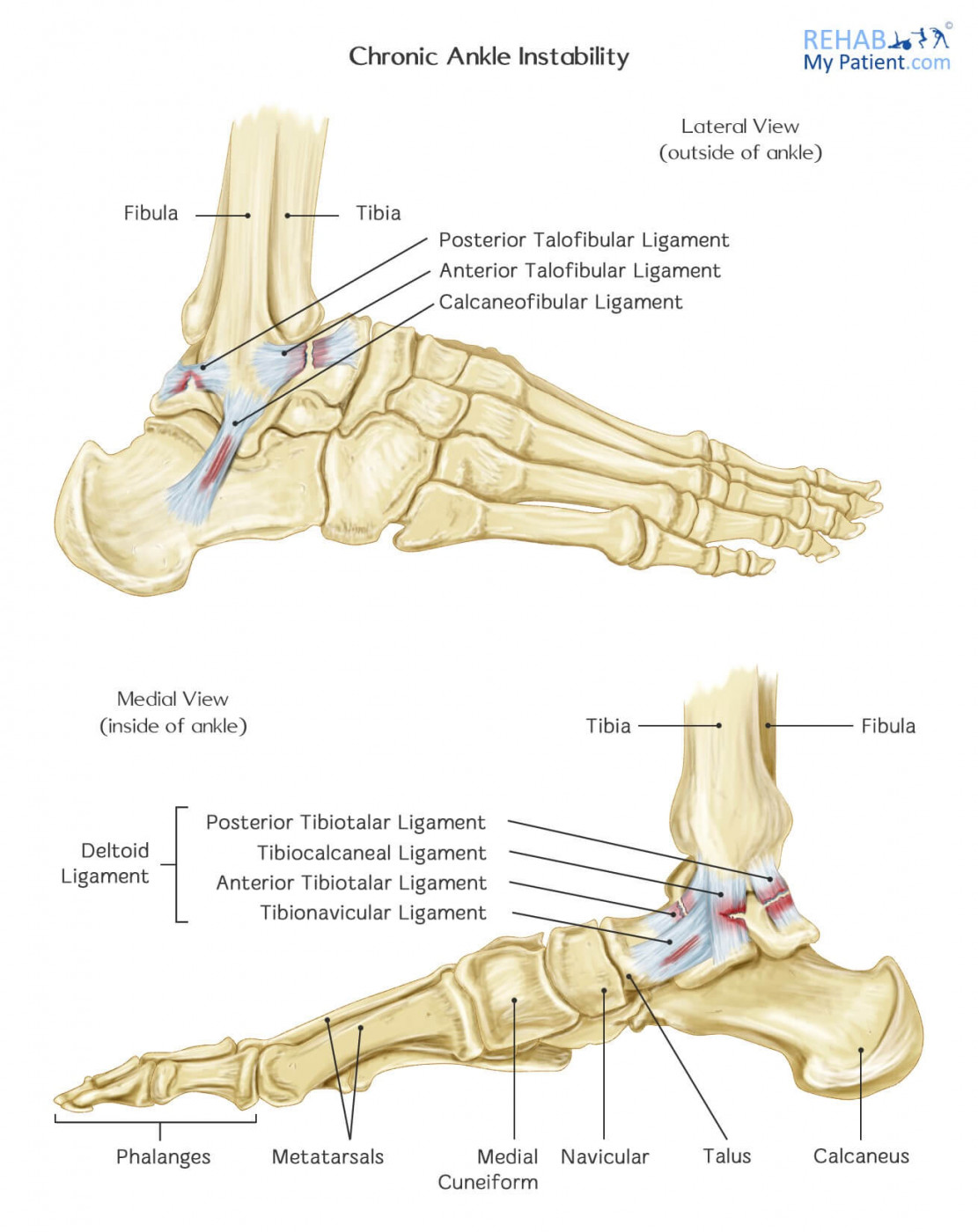
The ankle giving way on a recurring basis often characterizes chronic ankle instability. The condition will often form after an individual suffers from repeated ankle sprains. Most of the time, the giving way will occur when walking or performing other activities, but it can happen even when standing in one position. A number of athletes suffer from the condition. Those who have chronic ankle instability will often complain about:
- An ankle that repeatedly turns, especially when placed on an uneven surface or when engaging in sports
- Chronic swelling and discomfort
- Tenderness or pain along the outside or inside of the ankle
- Unstable or wobbly feeling in the ankle
- An inability to balance on one leg
Chronic Ankle Instability Anatomy
Three articulations make up the ankle: the fibula (outer bone of the ankle/lower leg), the tibia (shinbone) and the talus (this bone lies between the fibula and the tibia). The ankle ligaments hold the structure together and connect the bones together. A deltoid ligament holds the talus bone to the shinbone on the ankle's inside. On the ankles' outside, three smaller ligaments hold the talus bone to the fibula and one ligament from the calcaneus to the talus. There are also muscles surrounding the ankle that helps to propel it and let the athlete jump and run.
The big issue is that young ladies tend to develop this condition, typically from the ages of 13 to 19. It almost always occurs following a bad ankle sprain. About 75% of ankle sprains are actually recurrent, i.e. once you sprain the ankle, you are far more likely to re-sprain it. This is due to ligament damage. When you sprain the ankle, the ligament becomes torn, and in some cases does not heal properly. So this means the joints are more unstable as there is no ligament supporting the joints. This makes the ankle more prone to re-straining (rolling, turning, and spraining).
Chronic ankle instability is very common in sports where ladies have to turn or change direction quickly. Netball is one of the biggest culprits, where ladies must often strap the ankles regularly to prevent further turning of the ankles.

Hot to Treat Chronic Ankle Instability:
- Exercises
If the ankle is unstable, stabilize it! And how to stabilize the ankle? There are a number of exercises that can stabilize the ankle joint, including balance exercises, proprioception, walking exercises, and exercise band/theraband exercises.


- Physical Therapy
Manual therapy can help reduce muscle tension, mobilize scar tissue and improve healing to the ankle. Physical therapy can also involve a number of different exercises and treatments to strengthen the ankle, retrain your muscles, improve your range of motion and improve your balance. As you go through the rehabilitation process, you will probably receive training relating to your sport or activities.
- Bracing
Depending on the patient, you may need to wear an ankle brace to support the ankle and prevent it from turning unexpectedly. Bracing will help to prevent incurring additional sprains.
Strapping can also be useful with tape such a zinc-oxide, or hypafix. It acts in a similar way to the bracing but the taping is a little more patient-specific.
- Anti-Inflammatory Medication
Due to the movements in the ankle, the area can become inflamed and swollen. Thanks to an anti-inflammatory medication, you can help to reduce the amount of pain in your ankle and minimize swelling. This should only be taken short term however, and under the guidance of a medical practitioner. Using ice and heat provides a more natural alternative that may prove even better. Using 5-10 minutes of ice over the swollen part of the ankle followed by 20 minutes of heat, inflammation can be reduced. Make sure you wrap the ice and heat in a cover do not risk skin burn.
- Surgery
In certain instances, a foot and ankle surgeon will recommend surgery based upon how irresponsive and unstable the ankle is to all of the non-surgical approaches available. Surgery will often reconstruct and repair the damaged ligaments. Based on your individual case, the level of surgery will vary accordingly. Recovery periods will vary based on the various procedures performed.
Tips:
- Ankle instability leads to an inability to perform physical activities like running, playing sports, walking and standing. Without the ability to walk, your life will become a standstill.
- Most of the time, the instability is due to recurring sprains that result because the healing process has not fully completed.
- Balance exercises are key! Work hard on the ankle exercises and be persistent – it takes time.
- The majority of safety measures are common sense.
- By neglecting a minor injury, it can turn into a major disorder down the line. Seek advice from your therapist.
Sign Up
Sign up for your free trial now!
Get started with Rehab My Patient today and revolutionize your exercise prescription process for effective rehabilitation.
Start Your 14-Day Free Trial